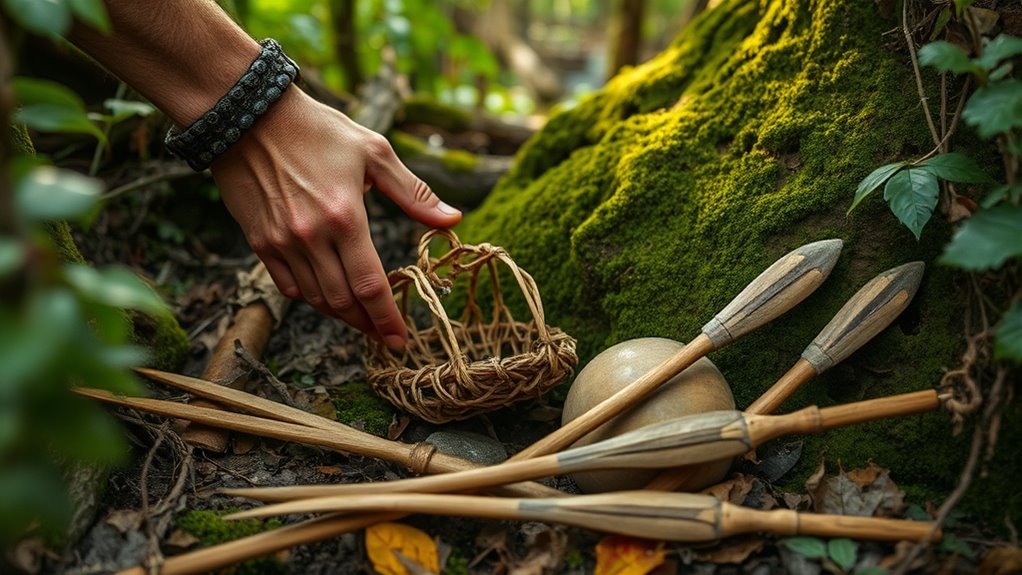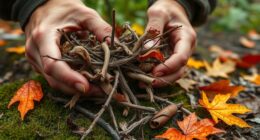You can master trapping and hunting with tools crafted entirely from foraged materials by selecting natural resources like sticks, vines, and bark, then shaping and weaving them into effective traps. Focus on understanding animal behavior, camouflaging your setups, and regularly checking your traps to guarantee humane and successful catches. Using eco-friendly methods improves sustainability and safety. Keep exploring, and you’ll discover more about creating efficient, natural traps that can sustain you in survival situations.
Key Takeaways
- Use natural, locally sourced materials like sticks, vines, and bark to craft traps and snares suited to the environment.
- Incorporate foraged foods such as fruits or seeds as bait to increase trap effectiveness.
- Build traps with notched sticks, woven plant fibers, and natural reinforcement for durability and concealment.
- Regularly inspect traps to ensure humane handling and prevent non-target catches using natural camouflage.
- Understand animal behavior and movement patterns to strategically place traps near water, trails, or feeding sites.
The Evolution of Trapping Techniques and Tools

The evolution of trapping techniques and tools reflects humanity’s ongoing ingenuity in hunting and survival. In prehistoric times, trapping was essential for food, fur, and safety. Early devices like simple deadfalls used natural materials such as rocks and wood to trap animals efficiently.
Indigenous cultures, like the Eskimos and Hopis, developed specialized traps, including whalebone nooses and rock slabs, tailored to their environments. These innovations demonstrate the significance of cultural adaptation in developing effective trapping methods suited to diverse ecosystems.
When Europeans arrived in the 1600s, they introduced steel traps, revolutionizing trapping with increased durability and effectiveness. Over time, trap design advanced with innovations like setguns, horizontal deadfalls, and netting techniques borrowed from Asian silk nets. These developments allowed for more targeted, efficient trapping, shaping the evolution from primitive tools to sophisticated devices tailored to specific species and environments. This progression also highlights the importance of technological innovation in the advancement of trapping methods.
Furthermore, the integration of modern materials such as plastics and reinforced metals has enhanced trap durability and safety, reflecting ongoing technological progress in this field. Additionally, the understanding of animal behavior and ecology has increasingly influenced trap design to reduce non-target catches and improve ethical standards, aligning with the broader principles of cultural intelligence in adapting to different environmental and cultural contexts. Recognizing ethical trapping practices has become crucial as conservation efforts and animal welfare considerations grow in importance.
Crafting Traps From Natural Materials

Crafting traps from natural materials requires understanding the local environment and selecting appropriate resources like willow, bamboo, grapevine, or bark. You’ll need these to build effective designs such as funnel traps, bird snares, or deadfalls.
Willow bark and grapevine serve as excellent cordage, tying components securely. The choice of materials depends on season and surroundings, so adaptability is key.
Willow bark and grapevine make versatile, natural cordage adaptable to seasonal changes.
Use springy saplings for trap springs, like in Paiute deadfalls, and long sticks for framing structures. Weaving materials such as cattail leaves, grass, or Virginia creeper reinforce the trap’s strength.
Securing components with natural cordage and using techniques like notching sticks or weaving over/under patterns ensure stability. A good understanding of local environment can significantly improve your success rate in trapping. Being aware of symptoms of breast cancer can aid in early detection and prompt medical attention, which is crucial for treatment outcomes. While skill and practice improve your success, understanding your environment helps you craft effective, sustainable traps.
Types of Traps Used in Survival Situations
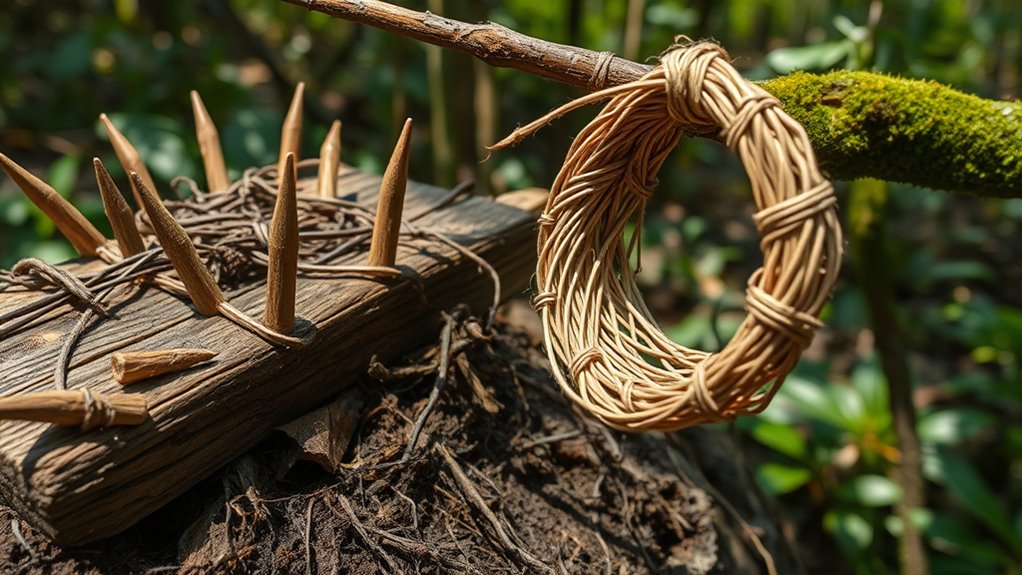
Understanding the different types of traps used in survival situations can greatly increase your chances of securing food when resources are limited. Deadfall traps, like the Paiute or Figure Four, use heavy objects or sticks to collapse on animals, relying on gravity or simple leverage. Mastering the principles of auditory processing can help in detecting animal sounds and movement, improving trap placement. Deep hole traps lure animals into pits they can’t escape, often combined with snares or bait. The success of these traps depends on proper placement, animal behavior, and environmental conditions. Regular maintenance and strategic positioning near animal paths maximize effectiveness. Adapting trap design to terrain and seasonal changes enhances your chances of capturing food efficiently in survival scenarios. Additionally, understanding the types of foraged foods, such as nuts, berries, and edible plants, can supplement your trapping efforts and improve your overall survival strategy. Developing an understanding of animal behavior can further increase the likelihood of successful trapping. Learning about prey movement patterns can also help refine trap placement and timing for better results. Utilizing technology like portable communication devices or GPS can also aid in navigation and trap placement in unfamiliar environments.
Ethical and Legal Aspects of Foraged Trapping

Ethical and legal considerations are essential when engaging in trapping, especially when using foraged tools, as they guarantee your actions support both animal welfare and wildlife conservation.
Ethically, you should handle animals humanely, minimizing stress and harm, and ensure quick retrieval and dispatch. Proper disposal of carcasses helps maintain ecosystem health and prevents offending others. Using as much of the animal as possible reduces waste. Additionally, understanding wildlife management principles can help you develop more sustainable trapping practices that benefit local ecosystems. Incorporating sustainable practices into your trapping methods can further enhance conservation efforts and reduce environmental impact. Awareness of animal welfare standards ensures your trapping methods align with ethical guidelines and promote humane treatment. Staying informed about regulations and permits is crucial to ensure compliance with local laws and avoid legal repercussions.
Handle animals humanely, minimize stress, and ensure prompt retrieval and disposal to support ethical trapping practices.
Legally, you must obtain landowner permission, set traps to avoid non-target animals, and record trap locations with waterproof tags. You’re responsible for following trapping regulations, reporting diseased animals, and checking traps frequently. Additionally, understanding private equity strategies can help you allocate resources effectively towards conservation initiatives.
Supporting conservation efforts and educating others about ethical trapping reinforces responsible practices, fostering community support and ensuring your trapping benefits both the ecosystem and wildlife.
Environmental Benefits and Considerations

Environmental benefits and considerations play a crucial role in shaping responsible trapping and hunting practices. When done properly, these activities help control invasive species, reducing property damage and protecting native ecosystems.
Regulated hunting and trapping manage wildlife populations, lowering the spread of diseases and parasites while supporting conservation efforts through funding. However, poorly regulated practices can harm biodiversity by over-reducing key species or disrupting ecological balances, such as affecting seed dispersal in forests. Additionally, sustainable practices ensure that these activities do not lead to overexploitation or long-term ecological damage. Implementing proper management strategies is essential for maintaining healthy populations and ecosystems.
They can also impact soil health and water quality if populations become unbalanced. Environmental monitoring through scientific research and community involvement can help identify and mitigate potential negative effects of trapping and hunting. Moreover, utilizing advanced ecological tools allows for more precise assessment of environmental impacts and helps in making informed decisions. Sustainable trapping and hunting, guided by strict regulations, promote ecosystem stability and help restore declining species. Additionally, high-quality projectors with accurate color reproduction can be used to monitor ecological changes and support conservation efforts more effectively.
When managed carefully, these practices support biodiversity, protect habitats, and contribute to long-term environmental health.
Practical Tips for Setting and Checking Traps
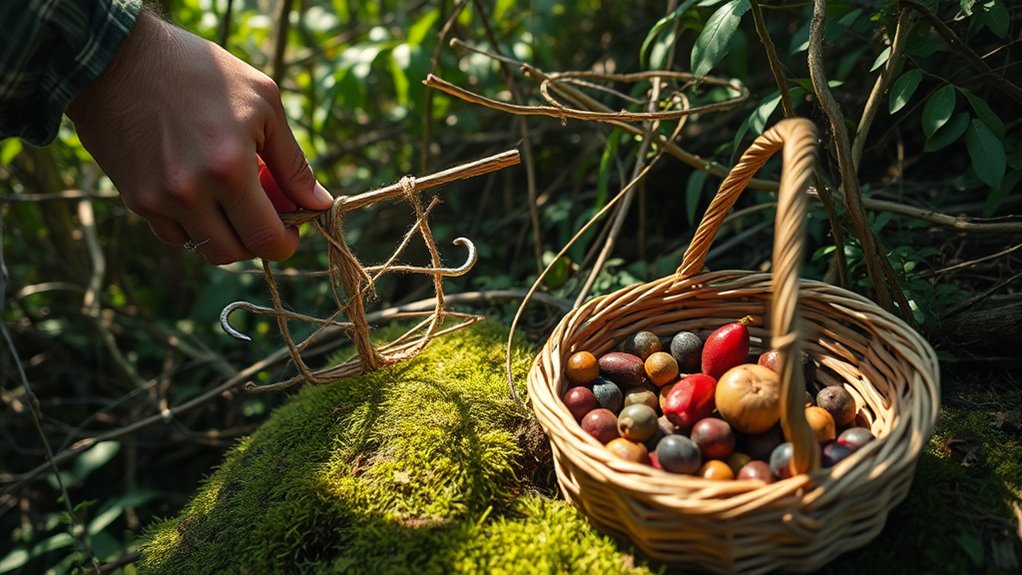
Setting and checking traps effectively requires careful planning and attention to detail.
First, select the right trap for the target animal, considering size and behavior.
Choose a strategic location where animals frequently pass, like near water or natural trails.
Use appropriate bait and natural lures to attract animals.
Stabilize traps with stakes or rocks to prevent movement, and cover them with natural materials to conceal scent and appearance.
Ensure traps are set to minimize animal panic and facilitate easy checking.
Regularly inspect traps to release non-target catches, prevent theft, and maintain proper function.
Keep tools accessible for quick maintenance.
Always follow local regulations and practice humane handling.
Incorporating SQA best practices such as regular audits and thorough documentation can help ensure the effectiveness and humane operation of your trapping activities.
Additionally, monitoring trap conditions and setting consistent schedules helps maintain trap efficiency and animal welfare.
Implementing proper maintenance routines can prolong trap lifespan and improve catch rates.
Recognizing the importance of sustainable practices ensures that trapping remains ethical and environmentally responsible.
Furthermore, understanding the behavioral patterns of target animals can improve trap placement and success rates.
Enhancing Survival Skills Through Foraged Trapping
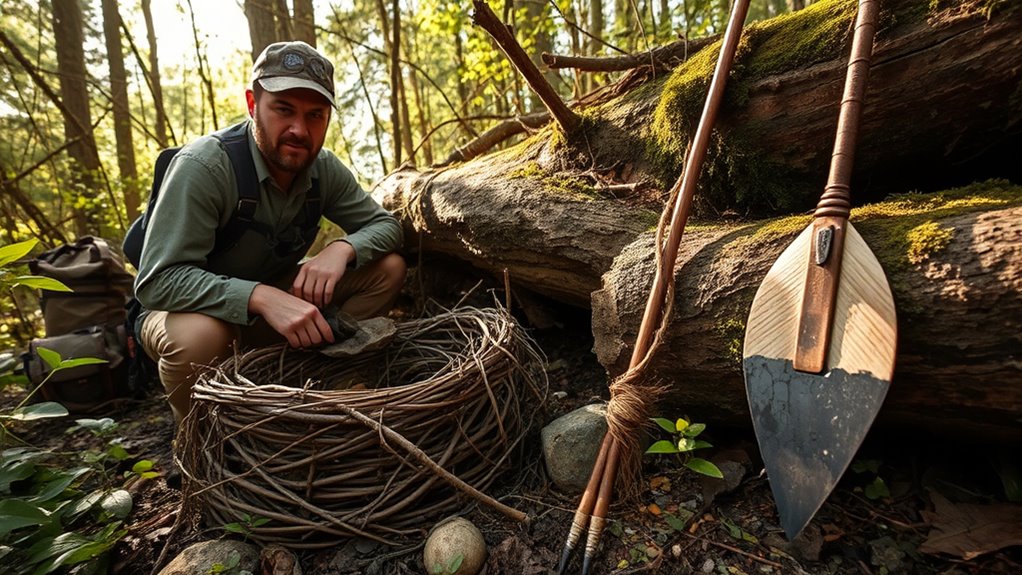
Enhancing your survival skills with basic traps starts by understanding how to use natural materials like sticks, rocks, and vines to craft effective hunting tools. You can build snares, deadfalls, or cage traps, each suited for small to medium animals like squirrels, rodents, and birds.
Adjust your traps based on terrain and climate to improve success rates. Camouflage traps with leaves or branches, and select bait like fruits or seeds to attract prey. Use sticks and rocks for trigger mechanisms, and place traps along animal paths or near food sources.
Incorporate foraged resources such as vines for cordage and appropriate woods for frames. Monitoring animal patterns and adapting trap designs to your environment boosts efficiency, making your trapping efforts more effective and sustainable.
Frequently Asked Questions
What Are the Most Effective Foraged Tools for Trapping Different Species?
You want to know which foraged tools work best for trapping different species. Using cordage made from plant fibers helps you craft effective snares and cage traps for small animals like rabbits and squirrels.
Wood and bamboo are great for setting up traps near animal pathways or burrows.
Rocks and logs help anchor your traps securely. By choosing the right materials and placement, you increase your chances of successfully catching various species.
How Do I Identify the Best Natural Materials for Durable Traps?
Your question is vital—choosing the best materials can make or break your success, and the difference is like night and day.
To identify durable materials, look for those that can withstand animal movement and weight, such as flexible branches like willow or maple, and strong vines or roots.
Opt for materials readily available in your environment, and test their strength by bending or pulling to guarantee they won’t break under pressure.
Can Foraged Traps Be Used Safely and Humanely in Emergencies?
You can use foraged traps safely and humanely in emergencies if you follow proper techniques. Guarantee minimal risk by using cage traps, which are designed to be humane and cause less harm.
Be skilled in trap setting, and always prioritize animal welfare by releasing non-target species unharmed. Quickly deploy adaptable traps suited to your environment, and follow local regulations to maintain safety and ethics.
Proper use maximizes effectiveness while respecting animal welfare.
What Are Common Mistakes When Setting Traps With Natural Materials?
When setting traps with natural materials, you often make the mistake of choosing improper materials, ignoring environmental conditions, and neglecting seasonal changes.
You might also overlook securing your trap properly, misjudge the right placement and height, or use ineffective camouflage.
Additionally, you may fail to test and maintain your traps regularly, and you mightn’t adapt your design to target specific animals.
These mistakes can reduce your success and safety.
How Do Regional Laws Impact Foraged Trapping Practices?
Regional laws immensely impact your foraged trapping practices by dictating where, when, and how you can trap. You must follow specific regulations on trap types, methods, and protected areas, which vary across regions.
Failing to adhere to these laws can lead to legal issues and harm wildlife populations. Staying informed about local rules ensures your trapping remains legal, humane, and environmentally responsible, helping you avoid penalties and support conservation efforts.
Conclusion
By mastering foraged trapping tools and techniques, you not only boost your survival skills but also connect deeply with nature. Some suggest that ancient trapping methods helped shape human ingenuity and even influenced our cognitive evolution. While modern ethics and laws guide us, understanding these primal skills can enrich your respect for the environment and your resilience. Embrace this knowledge, and you’ll be better prepared to adapt and thrive in any wilderness situation.

